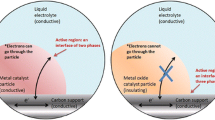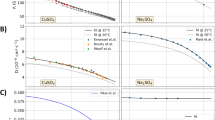Abstract
The rectification behaviour of three metal ion–metal interfaces and 38 concentration cells was studied. The rectification in Al∣Al3+∣Al was 35% (−0.4 to +0.80 V d.c.) between 2.0–5.0 V a.c. and for Zn∣Zn2+ ⋮ Al3+∣Al cell was 20% (+0.20 to −0.30 V d.c.). Its negative d.c. potential showed some similarity to a tunnel diode. 20% rectification was obtained when each of Al, Zn, Mg half-cell was coupled with I−, I2∣Pt half-cell and Al half-cell was coupled with Fe3+, Fe2+∣Pt half-cell. When the Zn half-cell was associated with Cr3+, Cr2O7 2−∣Pt half-cell the rectification was 15%, whereas the rectification in all other concentration cells varied from 1 to 12%. The possibility of obtaining much higher percentage of rectification can be explored in a large number of other metal ion–metal interfaces and concentration cells which can be assembled in a similar manner using the table of standard reduction potentials. The characteristics of a concentration cell can be varied by change in concentration of metal ion, redox ratio, variation of pH, temperature, effect of different additives to the cell solution, irradiation of electrode surface etc. Consequently, it will affect the percentage of rectification which may be of some use in commercial applications.
Similar content being viewed by others
References
K.S.G. Doss and H.P. Agarwal, J. Sci. Industr. Res. 9B (1950) 280.
G.C. Barker, in E. Yeager (Ed), ‘Transaction of the Symposium on Electrode Processes’ (J. Wiley & Sons, New York, 1961), p. 325.
G.C. Barker, in G.J. Hills (Ed), ‘Polarography’ (Macmillan, London, 1964), p. 25.
D.E. Smith and W.H. Reinmuth, Anal. Chem. 33 (1962) 482.
J. Paynter and W.H. Reinmuth, Anal. Chem. 34 (1962) 1335.
R. Neeb, Naturwiss. 49 (1962) 447.
G.C. Barker and H.W. Nurnberg, Naturwiss. 51 (1964) 191.
Y.Y. Gurevich and V.A. Myamlin, Dokl. Akad. Nauk., SSSR. 155 (1964) 1159.
P. Delahay, M. Senda and C.H. Weis, J. Am. Chem. Soc. 83 (1961) 312.
H. Imai and P. Delahay, J. Phys. Chem. 66 (1962) 1683.
H.P. Agarwal, Electrochim. Acta 17 (1972) 285.
H.P. Agarwal, Electrochim. Acta 16 (1971) 1395.
H.P. Agarwal, in A.J. Bard (Ed), ‘Electroanalytical Chemistry – a series of Advances', Vol. 7 (Marcel Dekker, New York, 1974), pp. 161–271.
H.P. Agarwal and P.K. Jain, Electrochim. Acta 26 (1981) 621.
H.P. Agarwal and M. Saxena, Ind. J. Chem. 16A (1978) 754.
H.P. Agarwal, in J.O'M. Bockris (Ed), ‘Modern Aspects of Electrochemistry’, No. 20 (Plenum Press, New York, 1989), pp. 177–263.
Author information
Authors and Affiliations
Corresponding author
Rights and permissions
About this article
Cite this article
Agarwal, K., Agarwal, H. Rectification behaviour of some metal ion–metal interfaces and concentration cells. Journal of Applied Electrochemistry 32, 1379–1382 (2002). https://doi.org/10.1023/A:1022630006302
Issue Date:
DOI: https://doi.org/10.1023/A:1022630006302




